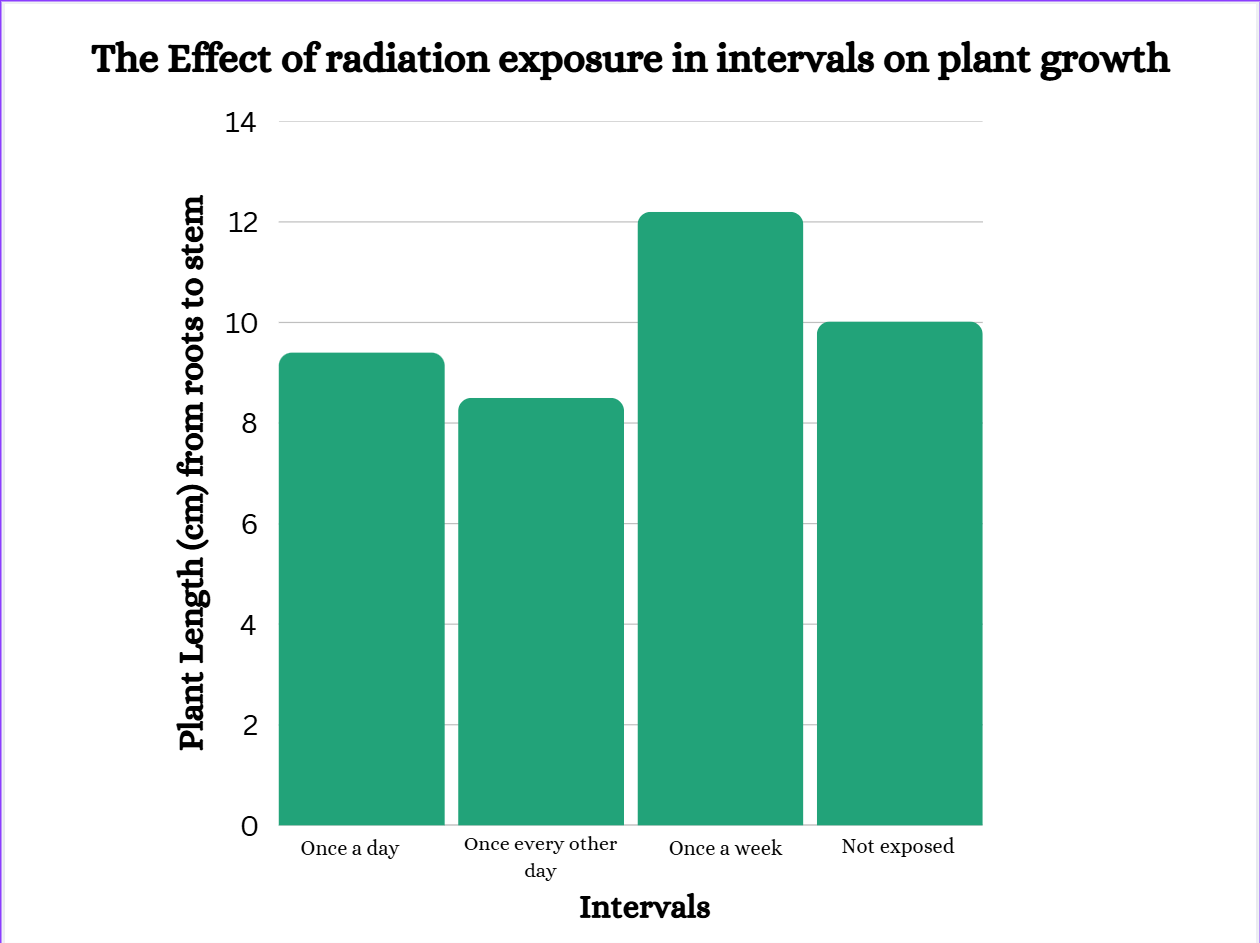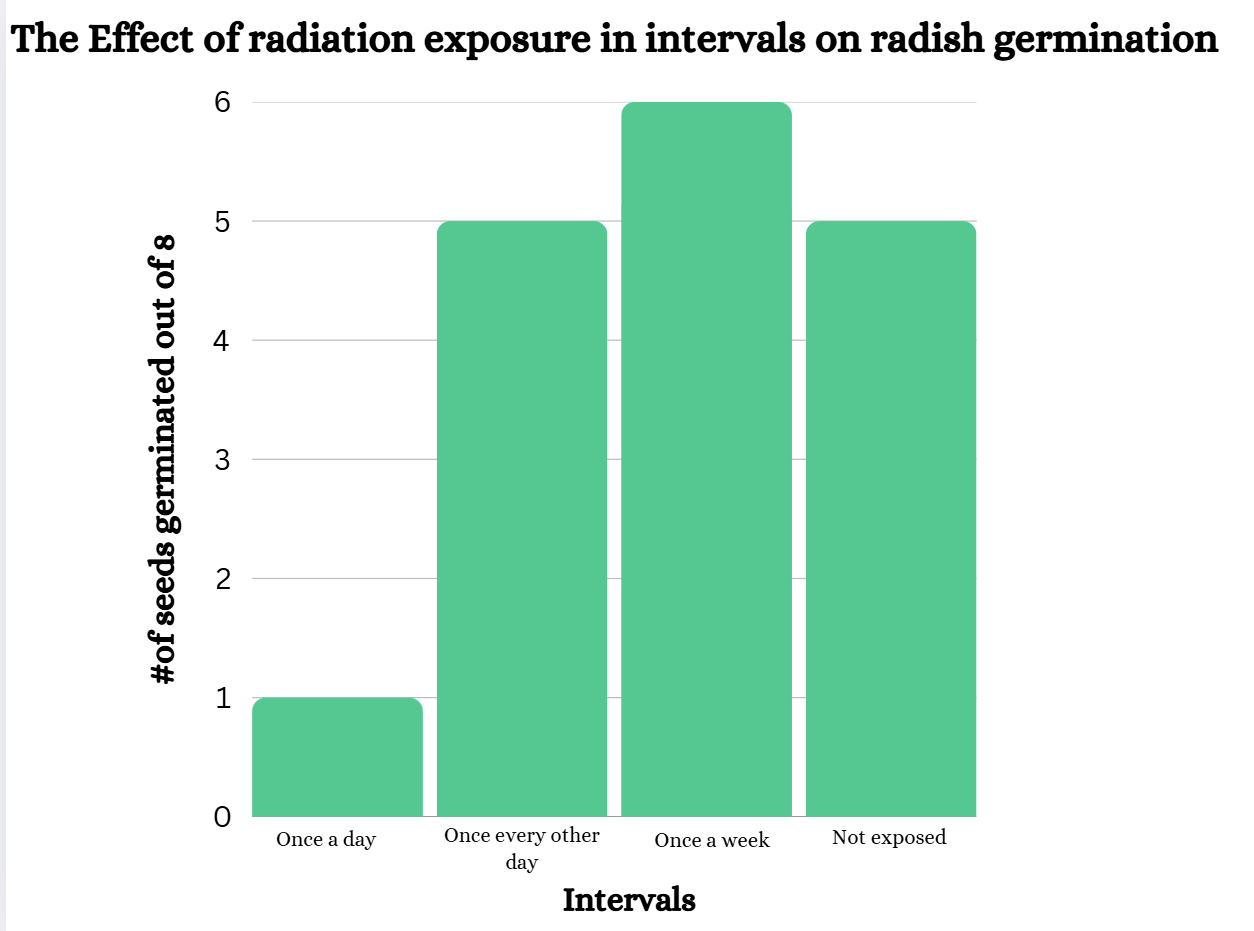The Effects of Non-ionizing Radiation on Plant Growth
Grade 8
Presentation
Hypothesis
If four different pots of radish plants (8 seeds per pot) are exposed to UV light at different intervals: once a day, once every other day, once a week, and not radiated at all, then the plants that were radiated once a week will grow the longest, whereas the plants that were exposed once a day will grow to be the shortest. The controlled group that was not exposed to UV will have the second most growth, follwed by the plant radiated once every other day. This is because UV radiation is a type of non-ionizing radiation that typically has a positive connotation; however, it can sometimes destroy cells in drastic amounts.
Research
Farmers often look for a way to increase the growth of plants, often using harmful chemicals for us or fertilizer. But what if there is a more effective natural way. What if there was another way closer to us then we realise?
Plants typically undergo a series of stages before reaching their full growth. It begins with seed germination. Seed germination is the process of a seed maturing into a seedling. If placed in the corrects settings (with an appropriate amount of water and UV light), the embryo cells begin to enlarge. The seed coating then breaks and slowly roots began to grow.
From there, leaves begin to shoot up from the maturing plant and it can now can food through a process of photosynthesis (the gaining of food for plants through sunlight). Once leaves are grown, the plant begins flowering, the process by which plants grow flowers. In some cases it can continue and plants begin to grow fruit. At this stage they are fully grown plants.
Radishes are a root vegetable of the brassicaceae family that are popular among new gardeners due to their low mantainance and quick growing speed. They are native to China and Southeast Asia, and thrive in the spring, fall, and winter. They generally tolerate temperatures between 65 and 85°F. In this experiment, we will be using Champion Radish Seeds.
There are two main types of radiation that we can find on Earth, ionizing and non-ionizing radiation. Non-ionizing radiation is often thought of with a positive, non-harmful connotation. This type of radiation does not carry enough energy to ionize atoms or molecules. All of us are exposed to non-ionizing radiation on a daily basis. However, many times, this type of radiation can destroy cells. Ionizing radiation is a type of radiation with enough energy they can alter the electron and proton balance in an atom. This creates ions, hence the name ionizing radiation.
Ultra violet radiation, commonly referred to as UV light is typically a form of non-ionizing radiation essential for all life on our planet. Typically on Earth, UV light is found from the Sun. UV light has a sort of spectrum of radiation. Stronger amounts are ionizing and lesser amounts are non-ionizing.
UV light can supply essential vitamins and growth in plants.
Ultra violet radiation has a positive effect on seed germination. A study by Pouria Sadeghianfar, Meisam Nazari, and Gunter Backes showed positive results when plant seeds were exposed to high levels of UV light (8 hours and 12 hours), the plants had the most positive amount of seed germination.
Variables
Manipulated: The manipulated variable is how often the radish plant are exposed to the UV light (once every other day, once every day, once a week, never).
Responding: The responding variable is the length of the radishes measured after a month of experimentation (ruler, cm).
Controlled: The controlled variables are the amount of time the plants are exposed to the plant growth light (9 hours), the amount of water given to each plant pot (20ml), the type of UV light being used (110-260 volt), and the amount of time the plants are exposed to radiation for (30 minutes). Additionally, one of the plants being grown will recieve no radiation as our control plant.
Procedure
Materials needed:
- 4 pots
- Plant seeds (in this experiment radishes) - Used 32 seeds for this project
- Water
-Sourse of light (plant grow light with blue, white, and red spectrum light that mimicks real sunlight)
- Form of non-ionizing radiation (here used a 110-260 volt UV LED lamp)
Step 1). Firstly separate the seeds into groups of eight.
Step 2). Plant the groups of eight into four pots.
Step 3). Begin growing the plants. Water with the same amount of water (20 ml per pot) and place them in the same area while exposing them to 9 hours to the plant grow light.
Step 4). Radiate each plant with the UV lamp (radiate one plant group once a day, one plant group once every other day, one plant group once a week, and one as control that would not be exposed ot any radiation)
Step 5). Unroot the plant at the end of the growing period (30 days)
Step 6). Measure the plants (in cm) from the roots to the top of the leafs
Observations
Germination Ratio
| Pot #1 | Pot #2 | Pot #3 | Pot #4 | |
| Intrevals of radiation | Once a day | Once every other day | Once a week | Not exposed |
| # of seed out of 8 that germinated after 30 days | 1/8 | 5/8 | 6/8 | 5/8 |
Effects of Non-Ionizing Radiation on Plant Growth
| Intrevals of radiation | Once a day | Once every other day | Once a week | Not exposed |
| Average growth of eight seeds in each pot (cm) | 9.4 | 8.5 | 12.2 | 10.02 |
Individual plant growth at the end of the 30 day growing period:
(Measured from the root to the stem)
Once a day:
Seed #1: 9.4 cm
Seed #2: 0 cm (not germinated)
Seed #3: 0 cm (not germinated)
Seed #4: 0 cm (not germinated)
Seed #5: 0 cm (not germinated)
Seed #6: 0 cm (not germinated)
Seed #7: 0 cm (not germinated)
Seed #8: 0 cm (not germinated)
Once every other day:
Seed #1: 10 cm
Seed #2: 9 cm
Seed #3: 6.1cm
Seed #4: 8.4 cm
Seed #5: 0 cm (not germinated)
Seed #6: 0 cm (not germinated)
Seed #7: 0 cm (not germinated)
Seed #8: 0 cm (not germinated)
Once every week:
Seed #1: 14cm
Seed #2: 8.3cm
Seed #3: 14.2cm
Seed #4: 11.6cm
Seed #5: 15.1cm
Seed #6: 10cm
Seed #7: 0 cm (not germinated)
Seed #8: 0 cm (not germinated)
Not Exposed:
Seed #1: 10cm
Seed #2: 9.5cm
Seed #3: 11.5cm
Seed #4: 9cm
Seed #5: 10.1cm
Seed #6: 0 cm (not germinated)
Seed #7: 0 cm (not germinated)
Seed #8: 0 cm (not germinated)
The plants being radiated once a week had ended up growing to be the largest in size with an average growth of 12.2 cm from the roots to the leaves. 6 out of the 8 seeds that had been planted ended up germinating and growing roots and leafs.
The plants radiated every day grew the least with growth of 9.4 cm from the roots to the leaves but on 1 out of the 8 seeds planted ended up germinating.
The radish seeds did not end up growing a bulb, this may have been due to the spacing in-between each of the seeds.
Analysis


The plants being radiated once a week had grown to be the largest form the roots to the tip of the leaf and plants being radiated once a day had grown the least.
The non-ionizing radiation had a somewhat positive affect on the plant growth. However, the plants radiated every single day had too much radiation. The non-ionizing radiation with the amount being radiated on the plants every day ended up destroying the plant cells. This led to the seeds not germinating and if germinated, with minimal growth.
Conclusion
In this experiment we tested the effects of non-ionizing radiation (in the form of a plant light) on radish seeds.
Our scientific question was how non-ionizing radiation affects radish plant growth. Based on our research, we hypothesised that the seeds radiated once a week will grow to be the tallest (cm, ruler), followed by 1 every two days, never, and finally 1 every day. Our hypothesis was proven correct
The radish seeds that were radiated once a week ended up having the best results, with a). the longest root to stem length and b). the most amount of plants grown from the pot. Once a day ended up with only one of the eight plants growing averaging to the worst results. Plants radiated once every other day ended up with an average growth of 8.5 cm and our control plants that were not exposed ended up growing an average of 10.02 cm. In conclusion, the plants which were radiated on a weekly basis ended up with the most growth.
Application
This project has many real world application. First and foremost, starting in a garden. Using non-ionizing radiation can positively affect plant growth, this can lead to the plants growing to be bigger and can reduce growing times.
Sources Of Error
The experiment was well executed, however it had a few flaws. There was time for one trial only. If we could re-do this a second time, we would do a few more trials (ex. 3-4 trials), this would give us more accurate results. During the plant growth process, the stems had grown but the radishes themselves did not. This may have been due to too many radishes seeds planted in the same pot. In the future, we would plant each radish seed to have their own pot to grow.
Citations
Cherlinka, V. (2025, February 28). Stages Of Plant Growth And Their Role In Agriculture. EOS Data Analytics. https://eos.com/blog/stages-of-plant-growth/
Facts About Radiation from Space (Cosmic Radiation). (2024, February 20). Radiation and Your Health. https://www.cdc.gov/radiation-health/data-research/facts-stats/cosmic-radiation.html#:~:text=Cosmic%20radiation%20consists%20of%20high,stars%2C%20including%20our%20own%20sun.
Lofgren, K. (2023, July 13). How to plant and grow radishes. Gardener’s Path. https://gardenerspath.com/plants/vegetables/grow-radishes/
NASA. (2025, February 7). Humans to Mars - NASA. https://www.nasa.gov/humans-in-space/humans-to-mars/
Sadeghianfar, P., Nazari, M., & Backes, G. (2019, February 24). Exposure to Ultraviolet (UV-C) Radiation Increases Germination Rate of Maize (Zea maize L.) and Sugar Beet (Beta vulgaris) Seeds. National Library of Medicine. Retrieved February 3, 2025, from https://pmc.ncbi.nlm.nih.gov/articles/PMC6409551/#:~:text=UV-C%20rad
Stamnes, K. (2003). ULTRAVIOLET RADIATION. Science Direct. Retrieved January 3, 2025, from https://www.sciencedirect.com/science/article/abs/pii/B0122270908004449
Types and sources of radiation. (2024, March 12). Canadian Nuclear Safety Commission. Retrieved February 3, 2025, from https://www.cnsc-ccsn.gc.ca/eng/resources/radiation/types-and-sources-of-radiation/#non-ionizing-radiation
Ultraviolet radiation. (2024, February 15). Radiation and Your Health. https://www.cdc.gov/radiation-health/features/uv-radiation.html
Acknowledgement
This project would not be possible without the support from a few important people. Firstly, we would like to thank our parents for their ongoing support and help. Ms. Jennifer Schmidt, our science teacher, for sharing the article that originally sparked this project. Finally, our science fair coordnator, Dr. Garcia.

